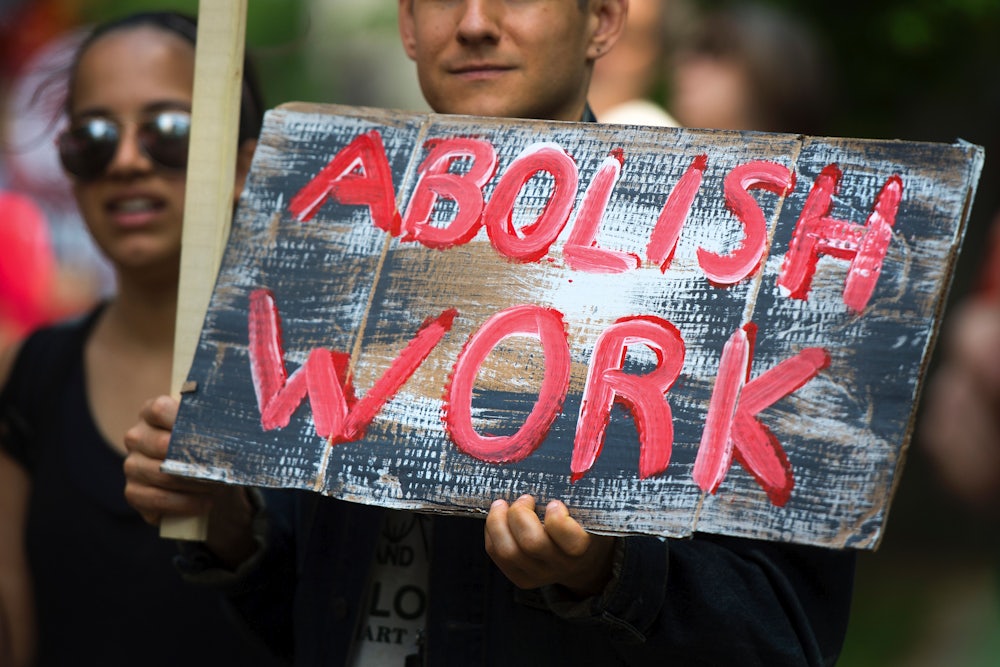In early November, a man named Bob Carroll, the executive director of the Detroit union-avoidance firm Permanent Solutions, logged on to LinkedIn to share a few phrases he said were crucial if an employer wanted to understand “what is happening RIGHT NOW in the workplace.” Among them were “Striketober,” “Anti-Work,” “the Great Resignation,” and, incredibly enough, “the YOLO Economy,” a term The New York Times coined this spring to describe the young and upwardly mobile who were, like a huge number of Americans, also quitting their jobs.
Carroll’s idea, I suppose, was to warn potential clients of the seismic shifts in the workforce and to terrify businesses into hiring Permanent Solutions to develop “strike contingency plans” and “union awareness trainings.” (Perhaps a better contingency plan might have prevented a certain coffee chain executive from drawing a parallel between his company and a concentration camp train.) But just as it’s been a big year for organized labor, it’s been a hell of a few months for the vast network of law firms, executive consultants, and human resources trade organizations that purport to help businesses keep workers from quitting or, God forbid, demanding different terms. For the people who produce slide decks or hold webinars to help managers wrestle every last dollar out of their employees, the moment is an opportunity to grow. The notoriously secretive, $340 million-a-year industry of union-avoidance firms is currently advertising based on the idea that the pandemic has put organizing on “steroids.” Management analysts, a growing segment of the economy, are earning their hefty salaries reimagining the messy, terrifying business of working through a pandemic as dual-tone infographics and recommendations that bosses become more “authentic.” For them, the reevaluation of work provoked by a year and a half of turmoil and sorrow is just another trend to be captured and redirected by corporate America.
This, of course, is how the management class has always tended to greet crisis: the cost of keeping employees alive shuffled into worker wellness programs or in-office clinics, requests for higher pay during a global catastrophe met with pizza parties and the promise of perks down the line. But it’s useful to trace how consultants and union-busting law firms are thinking about this moment and to see how cleanly they’re rolling a broad shift in how people think about work into bite-size “insights” with actionable goals. (You also won’t see many mentions of legislative relief like unemployment benefits in any of the scatter graphs explaining why workers are less interested in their office routines.)
To prepare for the unknowable future of employment, McKinsey recommends taking a page out of the military playbook and developing crisis teams. The Red Wolf Group, a leadership consulting firm, offers a “Resignation Readiness Scorecard” to see how prepared a manager is to “reimagine work.” And Morgan Lewis, the infamous anti-union law firm retained by both McDonald’s and Amazon, has run a number of presentations over the last year and a half specifically pegged to the pandemic. One, pitched to health care executives, was called “NLRA in the Time of Covid-19: The Rise of Employee Activism and Public Shaming of Employers and How Unions Are Taking Advantage.” It came with a strike map and an admonishment to monitor employees’ social media posts for evidence of latent organizing campaigns.
One particularly jarring feature of the material coming out of the management consulting world is how often it offers grim sets of statistics as proof of some greater and more optimistic trend—and how it brushes off material concerns about safety or pay in favor of more patronizing emotional concepts. Spend enough time on human resources blogs and you’ll find Microsoft’s 2021 “Work Trend Index,” a survey of 30,000 mostly digital workers that came up with such conclusions as “leaders are out of touch” and the workforce, while productive, is tired. As the report found, 61 percent of business leaders report to be “thriving,” while half of workers between 18 and 25 say they are barely surviving; nearly one in five workers Microsoft surveyed had cried with a colleague over the course of the pandemic. That number increases significantly for people with jobs in education or health care.
But as per the company’s report, these numbers should be taken to mean that a newfound “authenticity will spur productivity and wellbeing”: “The shared vulnerability of this time has given us a huge opportunity to bring real authenticity to company culture,” one executive surmised. Similarly, McKinsey published an extensive report in September concluding that “employees crave investment in the human aspect of work.” More than pay, benefits, or perks, the company that essentially invented management consulting reported, workers wanted to “feel valued.” The report was accompanied by a baffling chart plotting the importance for employees of health and compensation (somewhat or less important) alongside their having a sense of belonging and feeling valued (very important, according to the report).
But should all these attempts to weep with employees and tell them how important they are fail to reenergize the workforce, another industry is ready to step in. In parallel with management consultants’ lengthy reports, some of the biggest union-busting attorneys have released advertisements and papers aimed at managers concerned about the radicalizing effects of Covid-19. The Morgan Lewis presentation for health care executives collates social media reports and warns that “unions are using the pandemic to reposition themselves,” reminding managers to listen respectfully to employee complaints about their safety concerns around social distancing and personal protective equipment. Littler, another firm that has routinely represented employers in union disputes, published the first report from its “Global Workforce Transformation Initiative” this March, citing the “unprecedented and difficult challenges for employers” posed by “social justice issues” and unions “capitalizing on these issues to garner interest from employees in unique ways.” In its paper, the firm gives tips on what constitutes legal and illegal surveillance of employees who are working from home and recommends a stable of company-run social media sites to combat an emerging unionization campaign. (Such a campaign, the firm notes, requires maintaining “consistent effort and authenticity.”) But the bulk of its advice to managers trying to avoid worker organization focuses on a nebulous conception of corporate culture and the appearance, if not the reality, of taking worker contributions to heart: “In our experience, employees are generally less likely to engage in unionization efforts if they’re engaged and listened to, and involved,” the firm wrote. To achieve this, Littler recommends recurring team meetings and lots of video calls, as well as virtual happy hours and other “team-building events.” More Zooms!
Notably, Littler also cautions against taking company culture too far in the direction of a worker’s conscience. “Employers must be careful to avoid creating collective issues that may result in larger problems,” the report’s authors write. “For example, many high-tech companies promote free thought and expression and often encourage social justice advocacy. These goals are laudable, but they also may backfire because these advocates might target the company, the company’s customers … or other company decisions.” (Think of Google employees coming out against the company’s contracts with the Defense Department.) This is the closest any of these papers really comes to saying the quiet part out loud.
These reports are just the publicly available documents; who knows what these firms were saying to clients privately in boardrooms as Amazon changed the timing of traffic lights to prevent worker action or tens of thousands of Kaiser nurses prepared to walk off the job. It’s striking to see labor statistics wrapped in such measured language, all in the service of pretending nothing much at all has changed. But there really isn’t a pleasant spin on a wage freeze following record profits or a nice way to frame the idea that your boss was probably just as willing to let you die.










